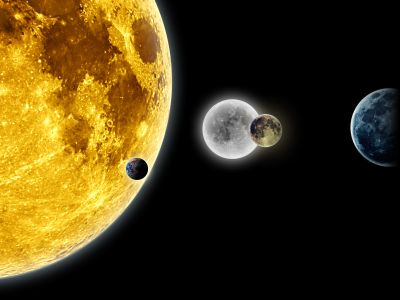``The moon was formed in just a few hours from the collision of the planets,'' shown in a study using a supercomputer, NASA released a simulation video

There are several hypotheses about the origin of the
Immediate Origin of the Moon as a Post-impact Satellite - IOPscience
https://doi.org/10.3847/2041-8213/ac8d96
Collision May Have Formed the Moon in Mere Hours, Simulations Reveal | NASA
https://www.nasa.gov/feature/ames/lunar-origins-simulations
How did the moon form? A supercomputer may have just found the answer | Live Science
https://www.livescience.com/moon-formed-in-hours-new-simulations-suggest
The question 'how was the moon formed?' has intrigued astronomers for many years. In recent years, the giant impact theory, which claims that a planet called Theia, which was about the same size as Mars, collided with the Earth about 4.6 billion years ago, formed the Moon.
However, there are multiple patterns in the giant impact theory, and there is room for debate as to how the moon was formed. 'Millions of pieces of Theia that collided with the Earth mixed with rocks and gases that vaporized from the Earth, forming a disk that slowly orbited the Earth and cooled over millions of years to become the Moon.' Hypotheses do not explain why the Moon's isotopic composition is similar to Earth's, even though much of the material is from Theia. Also, it is difficult to explain the current orbit of the moon with the hypothesis that `` the moon was formed in a disk made of material vaporized from the earth due to the collision of Theia ''.

Therefore, a research team led by Jacob
The research team used COSMA to simulate the collision between Earth and Theia at various angles, rotations and velocities. According to Kegerreis, the number of particles that can be modeled on a general computer is about 100,000 to 1 million, but COSMA can model as many as 100 million particles.
'With high-resolution computers, we can study the formation of the Moon in greater detail, just as large telescopes can take high-resolution images of distant planets and galaxies,' Kegerreis said. Simulations with too low a resolution can give misleading or simply wrong answers, for example, if you are building a model car out of toy blocks to simulate how it will break in a crash, dozens of 'If you build it out of blocks, it might break perfectly in the middle. But if you build it out of thousands or millions of blocks, it might break in a more realistic way.' .
Using high-resolution COSMA simulations, the researchers concluded that the Moon could have formed in just a few hours from Earth material ejected by planetary collisions and pulverized Theia debris. . This is the simulation video actually released by NASA.
New Supercomputer Simulation Sheds Light on Moon's Origin-YouTube
Thea is on the left of the screen, and the primitive earth is on the right.

Two celestial bodies collide ... ...

It divides into a large amount of fragments that melt into muddy.

However, the earth quickly regained its shape, and melted fragments extended from it like a tail.

The fragments become two lumps ......

The larger ones closer to the Earth were quickly absorbed, while the smaller ones farther from the Earth remained unabsorbed. It is said that this became the moon.

In the video, you can see the collision of Theia with the Earth and the formation of the Moon from different angles.

Our simulations show that the moon may have formed in just a few hours. In this scenario, the outer layer of the Moon is composed of approximately 60% primordial material, which would explain the similarity of the isotopic composition of the collected lunar samples and the Earth, as well as the tilted orbit of the Moon. will also be explained.

To prove that this scenario is correct, it is necessary to collect samples such as rocks from deep inside the lunar surface in future lunar explorations and analyze how the mantle is mixed. Kegerreis argues that if more monthly samples are available in the future, the analysis results can be reflected in the model to further improve accuracy. 'Such missions and studies are helping us narrow down the possibilities for the actual history of the Moon and Earth, and help us learn more about planet formation in and around our solar system,' he said.
Also, co-author of the paper, Vincent Eke of Durham University, said, ``The more we know how the moon was born, the more we can see the evolution of our planet.''
Related Posts:







